


In the Hubble Sequence of spirals, morphological classification is based on spiral arm texture and definition (see Sandage 1961). In this case, classification becomes directly linked to the relative star formation rate (SFR) via the illumination of the spiral pattern by young stars. In attempt to separate out this effect from the structural portion of morphological classification, van den Bergh (1976) proposed a 2D classification system involving spiral arm definition and bulge-to-disk ratio. In that system, he introduced a class of disk galaxies known as anemic galaxies. These are systems with weak spiral structure but they are generally not of low surface brightness (see also Bothun and Sullivan 1980).
It is well established that in Hubble Sequence spirals, the bulk of the star formation occurs within GMC's. This method of star formation gives rise to the formation of massive stars within stellar clusters, which ultimately drives the chemical evolution of galaxies. Galactic disks engage in star formation activity according to a criteria first established by Quirk (1972). The more recent expression of this criterion, by Kennicutt (1989), reflects a convolution of the rotation curve with the surface density distribution of gas. The result is a critical surface density of H I, as a function of radius, for the formation of molecular clouds and subsequence massive star formation. All data to date (e.g., van der Hulst et al. 1993, de Blok et al. 1996, Pickering et al. 1997) strongly suggests that LSB disks have an H I distribution which is largely below this threshold. It is therefore likely that LSB disks represent the evolutionary track taken by flattened-gas rich systems that are simply unable to form stars in the familiar environment of molecular clouds. If correct, this leads to the following set of expectations:
| (1) | The arm-interarm contrast in LSB disks should be quite low due to a paucity of O-stars and H II regions that generally define spiral arm structure |
| (2) | The overall star formation efficiency should be reduced and hence LSBs should evolve at a slower rate than those disks that form the Hubble sequence. |
| (3) | Massive star formation and hence metal-production should be inhibited in LSB disks. |
| (4) | LSBS disks should be relatively low in dust content. |
| (5) | If the characteristic spacing between newly formed stars depends upon the local environment, then star formation may be occurring in a more diffuse atomic H I medium. This would produce a lower luminosity density and a lower than average surface brightness disk. |
| (6) | No stars at all should form in LSB disks, if molecular clouds are truly required to initiate this process in all galactic environments. |
The observational properties that have been established for samples of LSB disk galaxies are largely consistent with these expectations. The most salient features are enumerated below:
1. LSB disk galaxies are not exclusively of low mass.
This is clearly seen in the distribution of 21-cm velocity widths which is
indistinguishable from any sample of Hubble Sequence spirals, as shown in
Figure 3. LSB disks have similar sizes and
masses as those high surface
brightness (HSB) that define the Hubble sequence. However, despite this
evidence to the contrary, there is a widespread notion that LSB galaxies
are exclusively low mass (or ``dwarf'') galaxies. Indeed, a small percentage
of the LSB population has truly impressive overall sizes with scale lengths
that exceed 15 h100-1 kpc.
Figure 4 shows that when one closes in
on a representative sample of galaxies, the entire disk structural plane
defined by  l and µ 0 is populated.
l and µ 0 is populated.
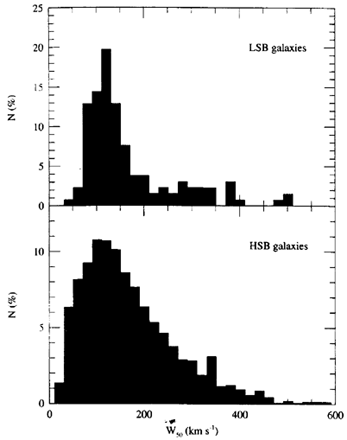
Figure 3. Fractional distribution of 21-cm velocity widths for samples of LSB and HSB galaxies. The data are 50% velocity widths. The LSB sample represents 131 galaxies which exhibit double-horned profiles from the Schombert et al. (1992) catalog and the HSB represents 1500 galaxies with double-horned profiles whose data has been compiled in the literature. |
2. Very few LSB galaxies show evidence for nuclear activity. This is in marked contrast to HSB disk galaxies where the percentage which have active galactic nuclei can be as high as 50%, depending on the mean luminosity of the sample. The most probable explanation for this is that LSB disks generally lack two structural features that facilitate gas flows and/or the formation of a compact object in the nucleus - bulges and bars. In this context it is interesting to note that about 50% of the large scale length LSB disk galaxies (e.g., Malin 1 and cousins) show some nuclear activity, and all have a normal bulge component with luminosity MB = -18 to -20. These galaxies are truly enigmatic in that ``normal'' formation processes were at work to create the bulge component but no conspicuous stellar disk ever formed around this bulge.
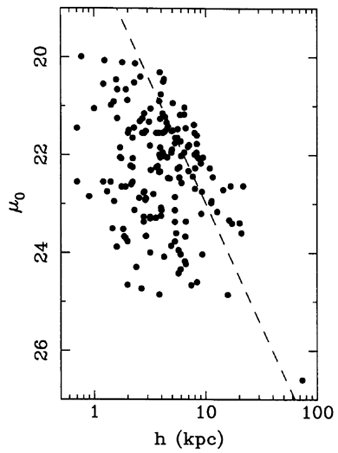
Figure 4. Plot of µ0 vs  l for
samples of LSB and HSB galaxies. The absence of HSB galaxies with large
values of l for
samples of LSB and HSB galaxies. The absence of HSB galaxies with large
values of  l is real; other than that, the two variables are
uncorrelated. The LSB data come from McGaugh and Bothun (1994) and
Sprayberry (1994) and the HSB
data come from de Jong (1995).
l is real; other than that, the two variables are
uncorrelated. The LSB data come from McGaugh and Bothun (1994) and
Sprayberry (1994) and the HSB
data come from de Jong (1995).
|
3. The amount of neutral hydrogen in LSB disks is very similar to HSB spirals except for their lower than average surface densities. A typical case is shown in Figure 5 where it can be seen that the gas density is generally below the threshold for molecular cloud formation and hence widespread disk star formation and metal production. LSB spirals are significantly deficient in molecular gas compared to HSB spirals of the same mass. Schombert et al. (1990) failed to detect a single LSB disk in CO (see also Knezek 1993). The mean upper limit on MH2 is an order of magnitude less than than the MHI = MH2 expectation. In some cases its nearly 2 orders of magnitude less. A recent calibration of the H2/ CO conversion factor as a function of metallicity (Wilson 1996), when applied to LSBs changes these limits by only a factor of 3. Furthermore, virtually none of the LSB galaxies detected by Schombert et al. (1992) or Impey et al. (1996) are IRAS sources.
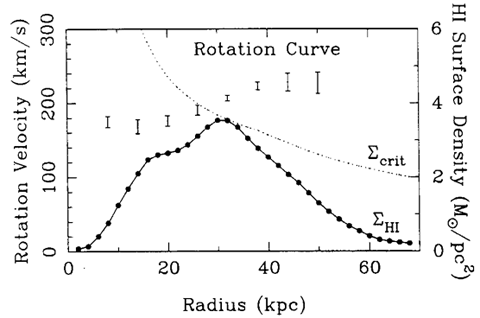
Figure 5. An example of a LSB disk galaxy rotation curve and surface H I distribution plotted against the critical surface density criterion of Kennicutt (1989). The galaxy depicted here is UGC 6614 where the data come from Pickering et al. (1997). The surface density of H I is everywhere below the critical density. At a radius of 30 kpc it rises to meet the critical density and a small amount of star formation, as evidenced by weak H II regions, is observed there (see data in McGaugh 1994). Most all LSB galaxies have measured surface densities of H I which are below the critical density (see also van der Hulst et al. 1993; de Blok et al. 1996). |
Although a typical LSB disk contains a handful of bright H II regions, indicating some current star formation, the average star formation rate is at least an order of magnitude lower than in similar mass disk galaxies. In our galaxy star formation is observed to only occur in GMCs (e.g., Young and Scoville 1991). LSB galaxies may well be devoid of molecular clouds in their interstellar medium but nevertheless formed some stars. We might speculate that the pressure-temperature-density manifold in LSB disks physically precludes molecular cloud formation. The expectation of low metallicity is confirmed by the observations of McGaugh (1992). As derived from H II region spectroscopy, the abundance of heavy elements such as oxygen, nitrogen, neon and sulfur can be an order of magnitude lower than HSB disks of the same mass. On average, LSB disk galaxies with L* luminosities have abundances of ~ 1 / 3 solar (McGaugh 1994). The largest LSBs known (e.g., Malin 2, UGC 6614) may have abundances near solar or in excess of solar - but these are rare objects. Thus, LSB galaxies strongly violate the mass-metallicity relation defined by Hubble sequence spirals. This shows that multiple paths of chemical evolution exist for disk galaxies, which in turn demands multiple star formation histories. The LSB disks represent some of the most unevolved objects in the universe.
4. Practically all of the LSB galaxies discovered to date
in photographically based surveys (described previously) are blue
despite the obvious lack of star formation. Mean colors
for these disks range from U - B = -0.17 ± 0.05, B -
V = 0.49 ± 0.04, and V - I = 0.89 ± 0.04
(McGaugh and Bothun 1994) to
B - V = 0.73 ± 0.05 and V - R = 0.50 ±
0.04 for the sample of very large scale length LSBs of
Sprayberry et al.
(1995a). In the most extreme cases, these galaxies, despite very low
star formation rates (~ 0.1 M per year), have disk
colors of B - V ~ 0.1 and V - I ~ 0.6. By way of comparison with
a large sample of galaxies which obey the Freeman Law,
de Jong & van der Kruit (1994)
found mean colors of B - V = 0.75
± 0.03 and V - R = 0.53 ± 0.04. One of the more curious
aspects of the color distributions of LSB samples is shown in
Figure 6 which indicates
that there is no correlation between µ 0 and
overall color. This means that the LSB disks cannot be the faded
remnants of HSB galaxies after star formation has subsided.
per year), have disk
colors of B - V ~ 0.1 and V - I ~ 0.6. By way of comparison with
a large sample of galaxies which obey the Freeman Law,
de Jong & van der Kruit (1994)
found mean colors of B - V = 0.75
± 0.03 and V - R = 0.53 ± 0.04. One of the more curious
aspects of the color distributions of LSB samples is shown in
Figure 6 which indicates
that there is no correlation between µ 0 and
overall color. This means that the LSB disks cannot be the faded
remnants of HSB galaxies after star formation has subsided.
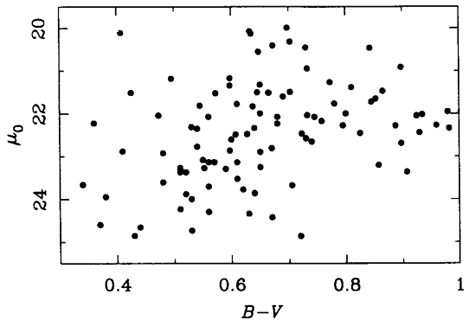
Figure 6. Non-correlation between the integrated disk color and observed µ 0 for the LSB sample of McGaugh and Bothun (1994). There is clearly no trend of increasing B - V with decreasing µ 0 as would be expected for a fading scenario. If anything, the mean B - V color get slightly bluer with decreasing µ 0. |
Figure 6 is very difficult to
interpret. Galaxies must fade and redden
as they age, but we see no evidence of this in our photographically selected
sample of LSBs. McGaugh (1996)
argues that this is a selection effect
which, depending on the plate material, might be
sufficiently severe to prohibit the detection of LSB disks with
B - V = 1.0. However, we expect that this selection effect is not
that severe as anything with B - V  1 and B(0) in the range
23.0-24.0
mag arcsec-2 should have been detected in these surveys.
Since we expect that such objects should exist, this suggests
that the intrinsic local space density of LSB galaxies is even larger than
suggested by Figure 1. Perhaps the
apparent absence of red LSBs can be
reconciled with a stellar population model and fading scenario which does
not lead to significant reddening. One way to offset the tendency for
stellar populations to redden as they age is to introduce an extremely
blue horizontal branch which is fed by the evolving stars on the giant
and asymptotic giant branch. Such populations have been seen in the
bulges of spirals and in ellipticals (e.g. O'Connell et al. 1992,
Ferguson et al. 1991,
Brown et al. 1996).
A minority of
other hot components such as Post Asymptotic Giant Branch (PAGB) stars
or Planetary Nebulae (PN) nuclei would
also aid in keeping these galaxies bluer as they fade. In fact, we can
successfully reproduce the observed colors of LSB disk systems by mixing
together three populations of stars:
1 and B(0) in the range
23.0-24.0
mag arcsec-2 should have been detected in these surveys.
Since we expect that such objects should exist, this suggests
that the intrinsic local space density of LSB galaxies is even larger than
suggested by Figure 1. Perhaps the
apparent absence of red LSBs can be
reconciled with a stellar population model and fading scenario which does
not lead to significant reddening. One way to offset the tendency for
stellar populations to redden as they age is to introduce an extremely
blue horizontal branch which is fed by the evolving stars on the giant
and asymptotic giant branch. Such populations have been seen in the
bulges of spirals and in ellipticals (e.g. O'Connell et al. 1992,
Ferguson et al. 1991,
Brown et al. 1996).
A minority of
other hot components such as Post Asymptotic Giant Branch (PAGB) stars
or Planetary Nebulae (PN) nuclei would
also aid in keeping these galaxies bluer as they fade. In fact, we can
successfully reproduce the observed colors of LSB disk systems by mixing
together three populations of stars:
The colors of LSB disks can be reproduced when  50% of the stars are
F2 and the ratio of hot evolved stars to giants is
50% of the stars are
F2 and the ratio of hot evolved stars to giants is  3:1. Unfortunately,
stellar evolution does not predict such a large ratio of hot evolved stars
to giants since the giant branch feeds the BHB stage where the
lifetime is somewhat shorter (see Bruzual and Charlot 1993).
Hence, this ratio should be unity at most. A ratio of unity, however,
produce a too red V - I color.
Theoretically, it is also possible that if the hydrogen envelope of
giant stars is completely lost during their evolution then the remnant core
will fall on the Helium main sequence which is considerably hotter and more
luminous, at a given mass, than the normal main sequence
(e.g. an 0.5 M
3:1. Unfortunately,
stellar evolution does not predict such a large ratio of hot evolved stars
to giants since the giant branch feeds the BHB stage where the
lifetime is somewhat shorter (see Bruzual and Charlot 1993).
Hence, this ratio should be unity at most. A ratio of unity, however,
produce a too red V - I color.
Theoretically, it is also possible that if the hydrogen envelope of
giant stars is completely lost during their evolution then the remnant core
will fall on the Helium main sequence which is considerably hotter and more
luminous, at a given mass, than the normal main sequence
(e.g. an 0.5 M Helium main sequence star has Teff
Helium main sequence star has Teff
 45000 K).This would
result in a substantial UV/blue contribution from evolved stars.
45000 K).This would
result in a substantial UV/blue contribution from evolved stars.
The above scenario is admittedly quite extreme, and it cannot be tested without UV observations of LSB galaxies. A large program aimed at determining fluxes of LSB disks at 2000 Å was approved as a Guest Investigator program for the UIT Telescope aboard Astro-2. Unfortunately, there was a complete failure in the first stage image intensifier of the A camera during the Astro-2 mission and none of the required data could be taken. Hence, we still don't know if optically LSB disk galaxies, in fact, have normal surface brightnesses in the UV. If they do, there are important implications regarding deep galaxy surveys (see below). In fact, a study of a deep Astro-I image of Fornax (see O'Neil et al. 1996) did show that some optically LSB objects could be detected at 1500 and 2000 Å.
If LSB galaxies do not have significant UV fluxes (which also contribute to the U and B passbands) then their blue colors are very difficult to understand. In most cases, the only physically plausible explanation is reduced contribution to the integrated light by giants. This requires these galaxies to have mean ages several Gyr younger than HSB disks of the same luminosity. This notion of delayed formation is somewhat consistent with the observed low densities of these objects as the dynamical timescale (a characteristic timescale over which an object collapses) can be an order of magnitude larger than HSB galaxies. Thus we might expect most LSB galaxies to have late collapse times and hence delayed formation of their first stars.
A recent development in the survey and detection of LSB galaxies
can counter the previous tendency to find only blue objects. The
first wide field CCD survey specifically designed to detect LSB
galaxies has been initiated by O'Neil et al. (1997a, b). This survey
was performed with the University of Texas McDonald Observatory
0.8m telescope between 1993 and 1996 using an LF1 2048 x 2048 pixel CCD
camera with a 1.32'' pixel size. The sensitivity of this survey
is about 1 mag arcsec-2 fainter than previous
photographically based surveys.
Fields in the Pegasus and Cancer clusters (these are
Virgo-like
structures at redshifts 4000-5000 kms-1
which are spiral rich) were selected along with many fields in the low
density environment defined by the Great Wall. The survey yielded the
discovery of 120 new LSB galaxies including, finally, a red component
to the LSB population. Figure 7 shows the color
distributions in
B - V for this sample. Note again there is no correlation
between color and µ 0. Even though this new
survey has detected LSB galaxies with fairly red integrated colors,
there is no sign of
a fading sequence. For this particular sample the average colors are
B - V = 0.79 ± 0.04, U - B = 0.08 ± 0.04, V -
I = 0.94 ± 0.06.
Approximately 20% of the sample has B - V  0.9 and U - B
0.9 and U - B  0.4, the colors that might be expected for a faded, relatively metal-rich
Hubble sequence spiral.
0.4, the colors that might be expected for a faded, relatively metal-rich
Hubble sequence spiral.
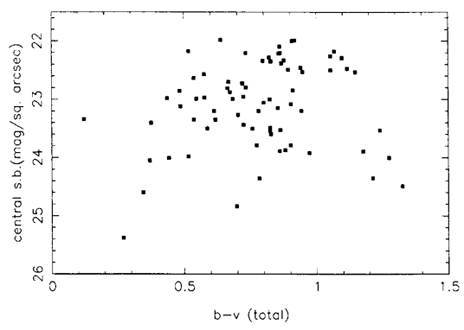
Figure 7. Plot of observed µ 0 and B - V for the Texas CCD based sample of O'Neil et al. (1997a). While there is still no correlation between µ 0 and B - V, the percentage of objects with B - V  0.8 is
significantly higher in this sample compared to samples of LSB galaxies
which are photographically selected. Consistent,
with those previous samples, however, very blue and very low
µ 0 galaxies also are present in this sample. 0.8 is
significantly higher in this sample compared to samples of LSB galaxies
which are photographically selected. Consistent,
with those previous samples, however, very blue and very low
µ 0 galaxies also are present in this sample.
|
5. Until very recently, almost nothing was known about the dynamics of rotating LSB disks. Optically, LSB disks galaxies rarely show the symmetry that is usually exhibited by Hubble Sequence spirals (but see Zaritsky and Rix 1997). To first order, strongly symmetric optical disks are a signature of rotation dominated kinematics within relatively cold disks. The ``chaotic'' optical appearance of many LSB disks might suggest peculiar kinematics, yet the global 21-cm profiles generally show the two-horned signature of a rotating disk. Some LSB disks are sufficiently gas-rich that their rotation curves can be derived from aperture-synthesis data. Two groups (de Blok et al. 1996; Pickering et al. 1997) have used the VLA and WSRT radio arrays to determine the 2D distribution of H I in about a dozen LSB galaxies. The results of these efforts can be summarized as follows:
| (1) | LSB galaxies have rotation curves that are shallower at small radii compared to HSB galaxies of the same rotation velocity and mass. |
| (2) | The gaseous component of LSBs is dynamically significant at virtually all radii. |
| (3) | LSB disks are dark matter dominated at virtually all radii. Compared to HSB galaxies of the same rotational velocity, LSB disks have globally and locally higher values of M / L (see also de Blok & McGaugh 1996). |
| (4) | In contrast to HSB galaxies, no ``maximum disk'' mass model fits the rotation curve. This means that there is no region in an LSB disk where the luminous (baryonic) matter dominates the potential and hence determines the form of the rotation curve. |
| (5) | Mass models derived from the rotation curves of LSB and HSB galaxies show that LSB galaxies inhabit less dense and more extended dark matter halos. However, they have dynamical masses comparable to those of HSB galaxies. |
| (6) | The most extreme examples give very hard upper limits to the
ratio of disk to halo mass. These result in baryon fractions of  10%
at the most, and more likely 10%
at the most, and more likely  3%. 3%.
|
This dynamical information can be interpreted in terms of the profound implication that the density profile of the dark matter halo ultimately determines the surface density of the galaxy which forms in that potential. Thus, LSB galaxies may well have fundamentally different dark matter distributions from HSB galaxies. This makes LSB disks physically distinct from HSB disks, even though they may have similar global properties. The paradoxical observation that LSB disks lie on the same Tully-Fisher relation as HSB disks (see Sprayberry et al. 1995b), albeit with significantly more scatter, can be understood if the ratio of dark-to-light matter in disk galaxies is independent of the dark matter halo density. In this case, galaxies of the similar circular velocity but dissimilar surface brightnesses can have the same luminosity because the LSB galaxy is defined by a larger radius which contains the mass that determines the circular velocity. This implies that LSB disks also have lower surface mass density.
These recent observations of LSBs also give rise to an important new
cosmological inconsistency. The rotation curves establish that LSB disks
are everywhere dark matter dominated and reveal a baryonic mass fraction
(fb) of  5% or less. Another environment which is everywhere dark
matter dominated is clusters of galaxies. White et al. (1993)
have argued that the ratio
5% or less. Another environment which is everywhere dark
matter dominated is clusters of galaxies. White et al. (1993)
have argued that the ratio  b /
b /  0 measured for a cluster should not be
significantly different than the universal value. If this is the case,
then
0 measured for a cluster should not be
significantly different than the universal value. If this is the case,
then  0 can be
determined from the relation:
0 can be
determined from the relation:
where  0 =
0 =  b /
fb,
b /
fb,
 b
is constrained by the observed abundances of light elements.
Current observations indicate that in clusters, fb
b
is constrained by the observed abundances of light elements.
Current observations indicate that in clusters, fb
 0.04h100-3/2. Combined with the
nucleosynthesis estimate of
0.04h100-3/2. Combined with the
nucleosynthesis estimate of  b ~
0.015h100-2 (Walker et al. 1991),
this leads to
b ~
0.015h100-2 (Walker et al. 1991),
this leads to  0
0  0.3h100-1/2. To reconcile this with
Einstein-DeSitter models requires either H0
0.3h100-1/2. To reconcile this with
Einstein-DeSitter models requires either H0  30 kms-1
Mpc-1, or that total cluster masses have been
systematically underestimated. The latter possibility does not appear to
be the case (Evrard et al.
1996) and hence the measured values of
fb in clusters appears quite inconsistent with
30 kms-1
Mpc-1, or that total cluster masses have been
systematically underestimated. The latter possibility does not appear to
be the case (Evrard et al.
1996) and hence the measured values of
fb in clusters appears quite inconsistent with  = 1. In contrast,
fb as measured in LSB disks is significantly lower
than the cluster value and is consistent with
= 1. In contrast,
fb as measured in LSB disks is significantly lower
than the cluster value and is consistent with  = 1. So which is the more
representative baryonic repository - clusters of galaxies or LSB
disks? Arguments given in Impey and
Bothun (1997) show that LSB galaxies
make a significant contribution to the total baryonic mass density
in the Universe, providing up to half of it depending on the faint
end slope of the luminosity function (see below).
= 1. So which is the more
representative baryonic repository - clusters of galaxies or LSB
disks? Arguments given in Impey and
Bothun (1997) show that LSB galaxies
make a significant contribution to the total baryonic mass density
in the Universe, providing up to half of it depending on the faint
end slope of the luminosity function (see below).